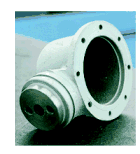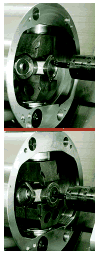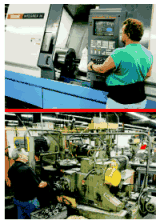Flexibility Doesn't Have To Be A Stretch
This company complements automatic machines with a versatile CNC turning center. The strategy provides many of the advantages of a fully flexible process.
Less than an hour of leadtime lets Schlumberger Industries turn, drill, and tap valve body components, where the same work once demanded a minimum leadtime of several days. The reasons for the improvement: faster setups and more efficient production. The result is a process responsive enough to produce these components within the time frame of even an emergency order. Dependence on a large, costly inventory of finished product is a thing of the past, because now there is an alternative-machining some or all of the pieces for the "quick-ship" order only after that order has been placed.
In short, Schlumberger's Owenton, Kentucky, manufacturing plant has achieved the transformation typical of shops that have abandoned automatic, mechanical processes in favor of more flexible machining via CNC (computer numerical control).
But with Schlumberger, there is an important difference: The old process still plays a key role within the new one. Automatic machines--specifically, three multispindle boring machines characterized by long setup times--continue to perform the bulk of the company's valve body machining.
Schlumberger didn't replace these machines, it complemented them. The automatics still provide productivity for large batches, as they have done in this plant for decades. But now, one versatile CNC turning center also machines many of the same parts--just in smaller batches, and with much shorter change--over times.
The turning center, a Mazak Integrex, combines rotary tools for milling and drilling with an SMW Autoblok indexing chuck capable of offering four different faces of the workpiece to the cutting tool in one cycle.
By strategically applying the flexibility this one machine offers, Schlumberger reaps most of the benefits of a fully flexible production operation. The company thereby illustrates the virtues not of a sweeping transition to CNC, but of the option that is far more accessible to most shops. That is, flexibility as leverage. Flexibility around the edges of the process.
The Application
Schlumberger (pronounced "shlumber-zhay") produces the valve bodies for its line of gas-pressure reducing regulators. These are key safety components that prevent gas pressure buildup. They are used primarily in natural gas distribution systems, but also in systems for other noncorrosive gases like air, nitrogen, and propane.
The valve bodies come in cast iron and cast aluminum. Schlumberger's Owenton plant machines these and other components in a production area that includes some two dozen machine tools. The same plant also assembles and tests the complete regulators, and it fulfills orders by shipping the finished product directly to customers.
The Mazak Integrex is one of four CNC machines in what has become a CNC shop-within-a-shop on the plant floor. The one other CNC lathe is a Mazak Quick Turn, used to perform simple turning of other regulator housing parts. The other two machines are Cincinnati Milacron Sabre vertical machining centers, used for batch drilling operations.
The Integrex machine actually supplements two methods for producing valve body components, both of which demand leadtime allowances. Automatic machining is one; the other is contracting to outside shops. In the first case, the setup time for the automatic machine is a key factor limiting how short the overall leadtime can be. In the second case, coordinating delivery to and from the contractor creates a leadtime delay.
So far, the CNC machine has only completely taken over production of one part from each approach. One is a cup-like valve bottom that used to be machined-in part-on one of the automatics. The other is a part formerly contracted out because it features flanges too large in diameter to fit on Schlumberger's machines.
However, programs for most of Schlumberger's related valve-body part numbers also reside on the Integrex control, and it is through these that the machine's flexibility has its greatest leveraging effect. Most of these parts are typically produced in large batches on one or more of the automatic machines. Now, the CNC turning center provides the capability to machine the same parts in small batches as needed. The plant often machines just one or two pieces at a time on the Integrex, to round out an existing batch of regulators to meet a customer's quick-ship order quantity.
Flexibility And Speed
But the leadtime advantage of the CNC machine is balanced by a simple argument in favor of the automatics: These machines are fast. Schlumberger's automatics are Goss & DeLeeuw 1-2-3 "chuckers," which simultaneously machine three faces of the same part from three different stations. They routinely process 500 parts per shift. As Schlumberger CNC group leader Kim Fox says of the automatic machines, "Once they're set up, no CNC machine can match their output."
However, setting up entails a series of hardware changes, including changing the chuck jaws, loading custom-made brazed tooling, and adjusting the machine for parameters like spindle speeds and feed rate. On two gear-actuated machines (a third is hydraulic), change-over to a new part also involves installing gears custom-made for that job. Setup on one of these machines often requires an entire eight-hour shift.
Sources of long leadtime can also come after the cut. The automatic machines have a limited range of motion, feeding only in and out along the part center line. When even custom tools don't let this feed reach all of the needed cuts, the unfinished workpiece goes on to additional processing on downstream machines.
The CNC turning center does require a longer machining cycle than the automatics, but it essentially eliminates these sources of out-of-cut time and expense. Change-over to a new part requires just loading a new program, and perhaps changing the jaws in the chuck. And with the CNC machine's ability to feed the tool to any point within the work zone, parts are machined complete without any additional stops.
This makes the CNC machine far more productive for machining small batches. The cost-effectiveness of the automatic machines grows with the production volume.
However, in Schlumberger's plant--as in most others--the non-CNC machines have something else to recommend them:
They were there first.
For this reason, the most economical process improvement is one that builds on the non-CNC foundation.
Schlumberger illustrates this. The company left large-batch machining to the Goss & DeLeeuw machines. But it complemented them with what is now by far the most flexible machine in its plant.
"Everyone Jumps"
The 35-hp Mazak Integrex that Schlumberger purchased is not so much a flexible machine as a flexible package. The flexibility comes from the meeting of the machine's features with the capabilities of the SMW Autoblok indexing chuck.
The Integrex itself has as much in common with a machining center as it does a CNC turning center, for several reasons. It feeds the tool in all three linear axes, not just two. Tools reside not on the turret, but in a tool storage magazine accessed by an automatic toolchanger. And for rotary tools-that is, tools for milling or drilling operations-the turret accepts a machining center's standard Cat No. 40 taper toolholders. (The Integrex is also notable for its ability to pivot the turret automatically, shifting the tool between horizontal and vertical orientations. However, Schlumberger's horizontal-only process doesn't employ this feature.)
The indexing chuck allows the machine to attack four faces of the workpiece in the same cycle. Two opposing jaws clamp the part, and the pivot for the index runs through the common center line of these jaws. By indexing the workpiece 90 degrees at a time about this pivot, the chuck lets the cutting tool reach all of the workpiece faces except the ones touching the jaws. Each 90-degree move takes about two seconds.
Custom-made jaws secure the irregularly shaped workpieces. These let turning operations machine features that the automatic machines produce using custom rotary tools and a stationary workpiece. Schlumberger purchased eight sets of the custom jaws, which together allow the chuck to hold about three dozen of the company's part numbers.
The chuck's clamp is secure enough to permit indexing even when the spindle is in motion. Schlumberger's chuck can and does safely reorient the workpiece at speeds up to 1800 rpm.
However, the effect can be unnerving to watch. The spinning mass seems to "morph" as the index re-sculpts its shape. For just an instant, this creates the optical illusion that the chuck is throwing the workpiece free.
"It takes some getting used to," Mr. Fox says. "Everyone jumps when they see it for the first time."
Accuracy Across Angles
This indexing chuck gives the turning center broad freedom to machine orthogonal features. Index the workpiece 90 degrees while the spindle rests, and one rotary tool can mill perpendicular surfaces or drill perpendicular holes, achieving what would otherwise require two rotary tools pointing in two different directions.
However, index while the workpiece spins, and the turning center can also face-turn perpendicular surfaces, or ID-turn holes that meet at a right angle inside the part. Both feats would otherwise require multiple setups, if not multiple machines.
Machining several faces in one cycle nets advantages beyond just productivity. Another benefit is accuracy. Some of Schlumberger's parts include orthogonal features that must locate with respect to one another. Handling the workpiece between machining these two features would leave this location accuracy in doubt. However, the repeatability of the chuck index ensures that they line up consistently on the Integrex.
Accuracy across right angles was a key reason why production of one of Schlumberger's parts was relocated entirely to the Integrex machine. The part, a "B35 bottom," resembles a tea cup about four inches in diameter, with the handle replaced by a broad stump. On the face of the stump is a line of three through-holes, two of which exist to permit linkage arms to reach a valve mechanism inside the cup. Two flats in the bottom of the cup support this same mechanism. Therefore, the holes must align with these flats, though one feature is offset from the other by 90 degrees.
Schlumberger's automatic machines do rotate the workpiece by 90 degrees from station to station, but they could not machine the two critical holes, which are off the center line. The part instead went to a drill press for this work. In fact, the part required three drill press setups after automatic machining was done, because holes in the flats and around the rim of the part are also off the center line.
"It was our most labor-intensive part," Mr. Fox says. The manual work left it prone to all of a drill press's hazards, including broken taps that have to be burned out of the holes. Handling from machine to machine also let error creep in between related features. Therefore, "it was also the part most likely to cause problems in assembly."
And there were the work flow problems. This part was one of the more difficult to set up on the automatic machines, "so once we got going, we would want to run at least 1,000 units," Mr. Fox says. However, the immediate result of this was 1,000 partially machined workpieces awaiting their three setups apiece at the drill presses.
Allocating the manpower to perform this machining was a challenge. "The automatic machines still had to be fed," Mr. Fox notes. So while workers were busy at the automatics, incomplete B35 bottom workpieces invariably queued near the drill presses.
CNC Cycle
The turning center cured in-process queuing. It now machines each B35 bottom complete in the following cycle:
The operator loads the workpiece in the indexing chuck with the "stump" facing out. With the spindle in motion, the turning center face-turns and profiles the stump, cuts an OD groove, and bores the center hole. The spindle then stops to allow rotary tools to machine the other two holes through drilling and reaming operations. Then the chuck indexes. A 90-degree move presents the cup of the part to the tool. The main spindle starts again, to let the machine face-turn the rim and the two flats, before coming to rest to let rotary tools drill and tap the holes in these surfaces.
The total cycle time is about eight minutes, but the efficiency gains have come from outside of this cycle. Eliminating mid-process handling results in a more accurate machining process. And the short setup time means there is no large investment in setup man-hours that must be amortized across the machining run. In other words, there is no longer a need to machine 1,000 pieces at once, all of which must be stored and tracked for as long as they remain under Schlumberger's roof.
Now, says Mr. Fox, "we just machine about 150 units and move on."
Pressure Regulator
But 150 is a large batch on the turning center. Schlumberger's more common application is to let the machine run just a handful of workpieces, for part numbers that are less complex than the B35 bottom. That is, parts which can be--and still are--profitably produced on the automatic machines.
In fact, if Schlumberger had the luxury of generous leadtimes for all of its parts, the automatic machines would probably provide the most profitable way to manufacture them. The rapid-fire production would compensate for long setup times, as well as for the expense of custom gears and tooling.
But Schlumberger does face quick-ship orders. Customer demand for three-day turn-around is not unusual, and even one-day orders can come in.
The possibility of receiving such short orders drove the need for costly inventories when Schlumberger had only the automatic machines to produce its valve body parts. Setup times for these machines are long enough, but their practical leadtimes are far longer. A new job rarely can be given immediate access to the machine, because the job on the machine at that moment has to be allowed to pay for its own long setup by running to completion. Therefore, the most economical way for Schlumberger to respond to quick-ship orders was to maintain a large inventory buffer from which these orders could be filled. This high inventory came with a high carrying cost. And most of this cost could be said to have been wasted, because it was spent on storing and tracking units for which the emergency order never came.
Now, CNC machining bleeds off the pressure to keep that buffer full. The fast change-over leaves time to machine and assemble a small batch of regulators within the window of even a quick-ship order.
The Sum Of The Parts
Schlumberger still does maintain an inventory, primarily because the automatic machine's batches are still run as large as possible to maximize cost-effectiveness. The difference is that Schlumberger's dependence on the inventory, like the inventory itself, is now much smaller.
For parts the turning center doesn't "own," it only rarely machines the units for an entire quick-ship order. More often it rounds out whatever regulator inventory is available--machining, say, the two pieces that are needed to turn the 48 regulators in inventory into the 50 units the customer ordered.
In other words, identical pieces within the same order can and often do come from both automatic and CNC machining. Schlumberger's use of CNC thus represents not a radical transition from its established process, just an effective one. By strategically applying a single CNC turning center, Schlumberger leverages a productive machining process into one that is still more productive--and a lot more flexible.
Related Content
Modern Bar Feeds Bring New Life to Automatic Swiss Lathes
Cam-actuated Swiss lathes are still the fastest way to process many parts. By adding modern bar feeders, this shop has dramatically improved their utilization with the ability to work unattended, even in a lights-out environment.
Read MoreHow to Start a Swiss Machining Department From Scratch
When Shamrock Precision needed to cut production time of its bread-and-butter parts in half, it turned to a new type of machine tool and a new CAM system. Here’s how the company succeeded, despite the newness of it all.
Read MoreInverting Turning and Five-Axis Milling at Famar
Automation is only the tip of the iceberg for Famar, which also provides multitasking options for its vertical lathes and horizontal five-axis machine tools.
Read MoreWatchmaking: A Machinist’s View
Old-world craftsmanship combines with precision machining on a vertical machining center and Swiss-type lathe to produce some of the only U.S.-made mechanical wristwatch movements.
Read MoreRead Next
The Cut Scene: The Finer Details of Large-Format Machining
Small details and features can have an outsized impact on large parts, such as Barbco’s collapsible utility drill head.
Read More3 Mistakes That Cause CNC Programs to Fail
Despite enhancements to manufacturing technology, there are still issues today that can cause programs to fail. These failures can cause lost time, scrapped parts, damaged machines and even injured operators.
Read More
.jpg;width=70;height=70;mode=crop)










.jpg;maxWidth=300;quality=90)






.png;maxWidth=300;quality=90)















.jpg;maxWidth=970;quality=90)